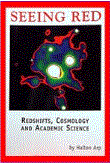
home •
about •
essential guide •
picture of the day •
thunderblogs •
news •
multimedia •
predictions •
products •
get involved •
contact

Credit: Lopez-Corredoira and Gutierrez 2002
pic of the day
archive
subject index
abstract
archive
Links:
Society for
Interdisciplinary
Studies
Redshifts, Cosmology and Academic Science
Author: Halton Arp, 6"x9" paperback, 314 pages, ISBN:0-9683689-0-5
A wonderful book, Seeing Red is a must read since it is both
educational and hard-hitting while being readable and entertaining. Arp
dismantles conventional astrophysics, based on redshift being
proportional to distance, by sharing his observations on quasars,
some of which are highly redshifted yet connected to low redshifted
galaxies by material bridges. Writing eye-opening material in more
than one arena, Arp takes on the corruption of good science in
academia, government and publishing after giving us great material
concerning red shift, the Big Bang, and cosmology.
Seeing Red can be ordered
via the link below.
Order Link $25.00
Feb 11, 2005
Thirty Years Later
"It seems likely that redshift may not be due to an expanding Universe, and much of the speculations on the structure of the universe may require re-examination." (Edwin Hubble, PASP, 1947)
"The evidence that many objects previously believed to be at great distances are actually much closer confronts us with the most drastic possible revision of current concepts." Halton Arp.
One of the more famous of those "many objects" is the galaxy imaged above, NGC 7603. Its fame is due to Fred Hoyle selecting it to illustrate his 1973 Russell Lecture before the American Astronomical Society. He referred to its connection with a higher-redshift companion as prototypical of observations that required an advance in physics beyond currently accepted theories. For the first time in the history of the prestigious Russell Lectures, the Astrophysical Journal didn't publish the address.
The advance in physics that Hoyle anticipated was an explanation for the ubiquitous shift toward longer wavelengths of the lines in galaxies' spectra. For over 70 years astronomers have insisted that such redshift was an indicator of distance. NGC 7603, with a redshift of .029, was 400 million light years away, and the companion, with a redshift of .057, was 780 million light years away—almost twice as far. The filament connecting the two had to be only apparent, a chance alignment of a foreground galaxy with a distant one.
But that facile dismissal of evidence strained one's confidence in coincidence. NGC 7603 was a Seyfert galaxy, a class of galaxies characterized by their activity, especially the activity of ejecting material such as this companion. And the interior of NGC 7603 was torn up: There was no other galaxy nearby, except the companion, to exert that kind of influence. And the unusual single arm ended on the companion—exactly what one would expect of an ejected, or even of a passing, galaxy. Straining coincidence even further was the observation that the companion had a deformed shape and a bright rim around it. The rim brightened exactly at the point of connection with the filament from NGC 7603.
If it were admitted that these two galaxies were physically connected, it would have to be conceded that at least some of the redshift in spectra was intrinsic, due to an unknown mechanism, and not an indication of distance. The theoretical edifice of the expanding universe and the Big Bang would be undermined if not demolished. The carefully built up map of the universe would have to be scrapped.
If astronomy were a science, astronomers would have made the investigation of anomalous redshifts and the discovery of an intrinsic redshift mechanism their top priority. Instead, they reacted by not publishing Hoyle's lecture and by denying telescope time to follow-up studies of NGC 7603. Arp noted, "It is a rare occasion when a person, even a scientist, is able to really look at a picture without forcing it into a frame of prior reference."
For 30 years institutional astronomy has buried its head in the sands of denial. But in 2002, two astronomers at La Palma took spectra of the galaxies and the connecting filament. They not only confirmed the discrepancy in redshifts of the galaxies but also discovered that the two quasar-like objects embedded in the filament (objects 2 and 3) have even greater discrepancies in redshift. If redshift indicated distance, the small objects would be 7 and 11 times farther away than NGC 7603. To dismiss this alignment as coincidence is to breathe sand.
On the 30th anniversary of Hoyle's lecture, Arp wrote: "I now personally regret that a generation has passed and we are further than ever from making that advance."
[See Arp's lecture video, "Intrinsic Redshift," for more details of this new picture of the universe.] Available from Mikamar Publishing
For good articles that deal with time and space see:
EXECUTIVE EDITORS:
David Talbott, Wallace Thornhill
MANAGING EDITOR: Amy Acheson
CONTRIBUTING EDITORS: Mel Acheson, Michael Armstrong, Dwardu Cardona,
Ev Cochrane, C.J. Ransom, Don Scott, Rens van der Sluijs, Ian Tresman
WEBMASTER: Michael Armstrong
Copyright 2005: thunderbolts.info
